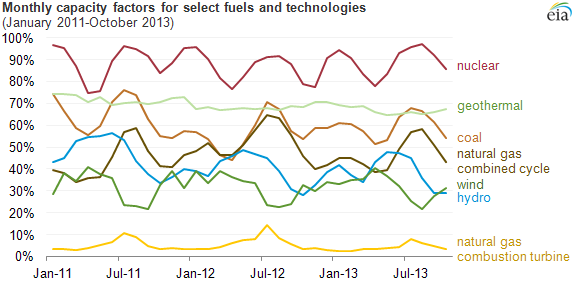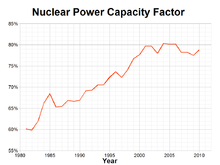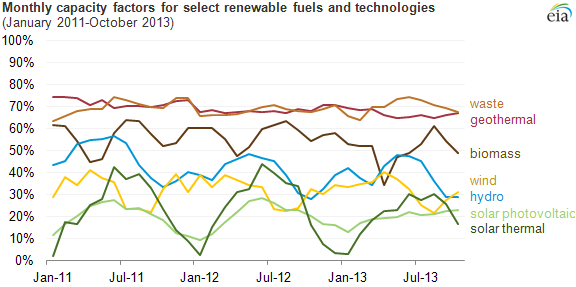Capacity factor

The net capacity factor of a power plant is the ratio of its actual output over a period of time, to its potential output if it were possible for it to operate at full nameplate capacity continuously over the same period of time. The capacity factor is calculated by dividing the total amount of energy the plant produced during a period of time and divide by the amount of energy the plant would have produced at full capacity. Capacity factors vary greatly depending on the type of fuel that is used, the design of the plant, its location, reliability, maintenance schedule and can also be subject to regulatory constraints and market forces. The capacity factor should not be confused with the availability factor, capacity credit (firm capacity), efficiency or cost of energy.
Sample calculations
Nuclear power plant

A nuclear power plant with a capacity of 1,000 megawatts (MW) might produce 648,000 megawatt-hours (MW·h) in a 30-day month. The number of megawatt-hours that would have been produced had the plant been operating at full capacity can be determined by multiplying the plant's maximum capacity by the number of hours in the time period. 1,000 MW × 30 days × 24 hours/day is 720,000 MW·h. The capacity factor is determined by dividing the actual output with the maximum possible output. In this case, the capacity factor is 0.9 (90%).[1]
Palo Verde Nuclear Generating Station is the largest nuclear plant in the US with a nameplate capacity of 3,942 MW between its three reactors. With an annual generation of 31,200,000 MWh in 2010,[2] the capacity factor was 90.4%.
Each of Palo Verde’s three reactors is refueled every 18 months, with one refueling every spring and fall. In 2014, a refueling was completed in a record 28 days.[3]
Wind farm
The Danish wind farm Horns Rev 2, the world's largest in 2009,[4] comprises 91 Siemens SWT-2.3-93 wind turbines each of 2.3 MW, with a nominal total capacity of 209 MW.
In 2012, the wind farm generated 956 GW·h of electricity.[5] The capacity factor for this wind farm was 52.1%.
Onshore wind farms can reach capacity factors of over 60%, for example the 44 MW Eolo plant in Nicaragua had a net generation of 232.132 MWh in 2015, equivalent to a capacity factor of 60.2%.[6]
Note that capacity factor is not constrained by the Betz limit so capacities higher that 59.2% are possible. This is because capacity measures actual production relative to possible production by the turbine, as opposed to production vs. energy available in the wind.
Hydroelectric dam
Large rivers or large reservoirs in wet mountainous areas are ideal water supplies for hydropower, in Western Canada the Peace and Columbia rivers support capacity factors averaging 85% of a 10,000MW capacity in the mild, rainy oceanic climate.[7]
[8] As of 2010, Three Gorges Dam is the largest power generating station in the world by nameplate capacity. In 2009, not yet fully complete, it had 26 main generator units @ 700 MW and two auxiliary generator units @ 50 MW for a total installed capacity of 18,300 MW. Total generation in 2009 was 79.47 TW·h, for a capacity factor of just under 50%:
Hoover Dam has a nameplate capacity of 2080 MW[9] and an annual generation averaging 4.2 TW·h.[9] (The annual generation has varied between a high of 10.348 TW·h in 1984, and a low of 2.648 TW·h in 1956.[9]) Taking the average figure for annual generation gives a capacity factor of:
Reasons for reduced capacity factor
This section needs additional citations for verification. (December 2010) |
There are several reasons why a plant would have a capacity factor lower than 100%. The first reason is that it was out of service or operating at reduced output for part of the time due to equipment failures or routine maintenance. This accounts for most of the unused capacity of base load power plants. Base load plants have the lowest costs per unit of electricity because they are designed for maximum efficiency and are operated continuously at high output. Geothermal plants, nuclear plants, coal-fired plants and bioenergy plants that burn solid material are almost always operated as base load plants.
The second reason that a plant would have a capacity factor lower than 100% is that output is curtailed or intentionally left idle because the electricity is not needed or because the price of electricity is too low to make production economical. This accounts for most of the unused capacity of peaking power plants. Peaking plants may operate for only a few hours per year or up to several hours per day. Their electricity is relatively expensive. Many other power plants operate only at certain times of the day or times of the year because of variation in loads and electricity prices. If a plant is only needed during the day, for example, even if it operates at full power output from 8 am to 8 pm every day all year long, it would only have a 50% Capacity factor, e.g.
A third reason is that a plant may not have the fuel available to operate all of the time. This can apply to fossil generating stations with restricted fuels supplies, but most notably applies to intermittent renewable resources. When the sun isn't shining, solar PV cannot produce electricity. When the wind is not blowing, wind turbines cannot produce electricity. Solar PV and wind turbines have a capacity factor limited by the availability of their "fuel", sunshine and wind respectively.
A hydroelectricity plant may have a capacity factor lower than 100% due to scarcity of water. However, its output may also simply be regulated to match the current power need, conserving its stored water for later usage. A hydroelectricity plant may also be designed for reverse usage so it can pump water up in its reservoir in situations with a power surplus. In both cases the use of the hydroelectricity plant to stabilize the grid reduces its capacity factor. Hydroelectricity may have a higher capacity factor with respect to the turbine size since in some case the amount of stored water fluctuates to account for intermittent availability of water.
Other reasons that a power plant may not have a capacity factor of 100% include restrictions or limitations on air permits and limitations on transmission that force the plant to curtail output.
Load following power plants
Load following power plants, also called intermediate power plants, are in between these extremes in terms of capacity factor, efficiency and cost per unit of electricity. They produce most of their electricity during the day, when prices and demand are highest. However, the demand and price of electricity is far lower during the night and intermediate plants shutdown or reduce their output to low levels overnight.
Capacity factor and renewable energy

When it comes to several renewable energy sources such as solar power, wind power and hydroelectricity, there is a fourth reason for unused capacity. The plant may be capable of producing electricity, but its "fuel" (wind, sunlight or water) may not be available. A hydroelectric plant's production may also be affected by requirements to keep the water level from getting too high or low and to provide water for fish downstream. However, solar, wind and hydroelectric plants do have high availability factors, so when they have fuel available, they are almost always able to produce electricity.[10]
When hydroelectric plants have water available, they are also useful for load following, because of their high dispatchability. A typical hydroelectric plant's operators can bring it from a stopped condition to full power in just a few minutes.
Wind farms are variable, due to the natural variability of the wind. For a wind farm, the capacity factor is mostly determined by the availability of wind. Transmission line capacity and electricity demand also affect the capacity factor. Typical capacity factors of current wind farms are between 25 and 45%, though current 110 meter towers can have up to 55% capacity factor, and future 140 meter towers are expected to have up to 65% capacity factor.[11]
Solar energy is variable because of the daily rotation of the earth, seasonal changes, and because of cloud cover. According to,[12] the Sacramento Municipal Utility District observed a 15% capacity factor in 2005. However, according to the SolarPACES programme of the International Energy Agency (IEA), solar power plants designed for solar-only generation are well matched to summer noon peak loads in areas with significant cooling demands, such as Spain or the south-western United States,[13] although in some locations solar PV does not reduce the need for generation of network upgrades given that air conditioner peak demand often occurs in the late afternoon or early evening when solar output is reduced.[14][15] SolarPACES states that by using thermal energy storage systems the operating periods of solar thermal power (CSP) stations can be extended to become dispatchable (load following).[13] The IEA CSP Technology Roadmap (2010) suggests that "in the sunniest countries, CSP can be expected to become a competitive source of bulk power in peak and intermediate loads by 2020, and of base-load power by 2025 to 2030".[16] A dispatchable source is more valuable than baseload power.[17]
Geothermal has a higher capacity factor than many other power sources, and geothermal resources are available 24 hours a day, 7 days a week. While the carrier medium for geothermal electricity (water) must be properly managed, the source of geothermal energy, the Earth's heat, will be available for the foreseeable future.[18] Geothermal power can be looked at as a nuclear battery where the heat is produced via the decay of radioactive elements in the core and mantle of the earth.
Real world capacity factors
United States
According to the US Energy Information Administration (EIA), in 2009 the capacity factors were as follows:[19]
- Nuclear–90.3%
- Coal–63.8%
- Natural Gas Plant–42.5%
- Hydroelectric–39.8%
- Renewables (Wind/Solar/Biomass)–33.9%
- Oil–7.8%
However, these values often vary significantly by month.
- Nuclear power 88.7% (2006 - 2012 average of US's plants).[20]
- Hydroelectricity, worldwide average 44%,[21] range of 10% - 99% depending on water availability (with or without regulation via storage dam).
- Wind farms 20-40%.[22][23]
- CSP solar with storage and Natural Gas backup in Spain 63%.[24]
- CSP solar in California 33%.[25]
- Photovoltaic solar in Germany 10%, Arizona 19%.[26][27][28]
- Photovoltaic solar in Massachusetts 13-15%.[29]
United Kingdom
The following figures were collected by the Department of Energy and Climate Change on the capacity factors for various types of plants in UK grid:[30][31][32][33][34][35]
| Plant type | 2007 | 2008 | 2009 | 2010 | 2011 | 2012 | 2013 | 2007–2012 average |
|---|---|---|---|---|---|---|---|---|
| Nuclear power plants | 59.6% | 49.4% | 65.6% | 59.3% | 66.4% | 70.8% | 73.8% | 61.9% |
| Combined cycle gas turbine stations | 64.7% | 71.0% | 64.2% | 61.6% | 47.8% | 30.3% | 27.9% | 56.6% |
| Coal-fired power plants | 46.7% | 45.0% | 38.5% | 40.2% | 40.8% | 56.9% | 58.4% | 44.7% |
| Hydroelectric power stations | 38.2% | 37.4% | 36.7% | 24.9% | 39.2% | 35.8% | 31.7% | 33.7% |
| Wind power plants | 27.7% | 27.5% | 27.1% | 23.7% | 29.9% | 29.0% | 32.3% | 27.5% |
| Photovoltaic power stations | 9.9% | 9.6% | 9.3% | 7.3% | 5.1% | 11.2% | 10.2% | 8.6% |
| Marine (wave and tidal power stations) | 4.8% | 8.4% | 3.8% | 8.3% | 9.7% | |||
| Bioenergy power stations | 56.5% | 55.2% | 44.8% | 47.9% | 58.0% |
See also
References
- ^ Glossary Capacity factor (net)
- ^ http://www.eia.gov/nuclear/state/arizona/
- ^ https://www.aps.com/en/ourcompany/news/latestnews/Pages/palo-verde-unit-2-ranked-as-top-us-generator-for-2013.aspx
- ^ Matthew McDermott. "Denmark Inaugurates World's Largest Offshore Wind Farm - 209 MW Horns Rev 2". Retrieved 2011-04-21.
- ^ "Horns Rev 2 production and capacity factors". Retrieved 2015-09-05.
- ^ "Centro Nacional de Despacho de Carga". Retrieved 2016-07-29.
- ^ https://www.bchydro.com/content/dam/hydro/medialib/internet/documents/info/pdf/info_iep_dependable_capacity_and_firm_energy.pdf pg12
- ^ https://www.bchydro.com/content/dam/hydro/medialib/internet/documents/info/pdf/info_iep_dependable_capacity_and_firm_energy.pdf
- ^ a b c "Hoover Dam - Frequently Asked Questions and Answers". United States Bureau of Reclamation. February 2009. Retrieved 2010-08-07.
- ^ How Does A Wind Turbine's Energy Production Differ from Its Power Production? Archived March 13, 2008, at the Wayback Machine
- ^ http://cleantechnica.com/2015/08/04/wind-could-replace-coal-as-us-primary-generation-source-new-nrel-data-suggests
- ^ Tom Blees (2008). Prescription for the Planet,. ISBN 1-4196-5582-5.
- ^ a b Thomas R. Mancini and Michael Geyer (2006). Spain Pioneers Grid-Connected Solar-Tower Thermal Power SolarPACES, OECD/ IEA, p. 3.
- ^ Muriel Watt Value of PV in summer peaks Archived February 17, 2011, at the Wayback Machine
- ^ Government of South Australia (2007), p.13,14 South Australia’s Feed-In Mechanism for Residential Small-Scale Solar Photovoltaic Installations Archived December 5, 2010, at the Wayback Machine
- ^ International Energy Agency (2010). Technology Roadmap: Concentrating Solar Power p. 5.
- ^ Why CSP Should Not Try to be Coal
- ^ A Guide to Geothermal Energy and the Environment
- ^ Electric Power Annual 2009 Table 5.2 April 2011
- ^ "U.S. Nuclear Capacity Factors". Nuclear Energy Institute. Retrieved 2013-10-26.
- ^ Hydropower[permanent dead link] p. 441
- ^ "Wind Power: Capacity Factor, Intermittency, and what happens when the wind doesn't blow?" (PDF). Renewable Energy Research Laboratory, University of Massachusetts Amherst. Archived from the original (PDF) on 2008-10-01. Retrieved 2008-10-16.
{{cite web}}: Unknown parameter|deadurl=ignored (|url-status=suggested) (help) - ^ "Blowing Away the Myths" (PDF). The British Wind Energy Association. February 2005. Archived from the original (PDF) on 2007-07-10. Retrieved 2008-10-16.
{{cite web}}: Unknown parameter|deadurl=ignored (|url-status=suggested) (help) - ^ "Torresol Energy Gemasolar Thermosolar Plant". Retrieved 2014-03-12.
- ^ "Ivanpah Solar Electric Generating Station". National Renewable Energy Laboratory. Retrieved 2012-08-27.
- ^ http://www.theenergycollective.com/robertwilson190/288846/low-capacity-factors-challenge-low-carbon-energy-transition
- ^ Laumer, John (June 2008). "Solar Versus Wind Power: Which Has The Most Stable Power Output?". Treehugger. Retrieved 2008-10-16.
- ^ Ragnarsson, Ladislaus; Rybach (2008-02-11). O. Hohmeyer and T. Trittin (ed.). The possible role and contribution of geothermal energy to the mitigation of climate change (pdf). Luebeck, Germany. pp. 59–80. Retrieved 2009-04-06.
{{cite book}}: Unknown parameter|conference=ignored (help)CS1 maint: location missing publisher (link) - ^ Massachusetts: a Good Solar Market
- ^ Digest of United Kingdom energy statistics (DUKES) for 2012: chapter 5 - Electricity
- ^ Digest of United Kingdom energy statistics (DUKES) for 2012: chapter 6 - Renewable sources of energy
- ^ Digest of United Kingdom energy statistics (DUKES) for 2013: Chapter 5 - Electricity
- ^ Digest of United Kingdom energy statistics (DUKES) for 2013: chapter 6 - Renewable sources of energy
- ^ Digest of United Kingdom energy statistics (DUKES) for 2014: Chapter 5 - Electricity
- ^ Digest of United Kingdom energy statistics (DUKES) for 2014: chapter 6 - Renewable sources of energy






